THE FORUM FOR ADVANCEMENT OF THREE DIMENSIONAL IMAGE TECHNOLOGY AND ARTS
The 20th Anniversary of 3D Forum (The 77th Meeting)
University of Electro-Communications, Chofu, Tokyo, Japan
September 8, 2006
Anomalous motion illusion and stereopsis
Akiyoshi KITAOKA
(Department of Psychology, Ritsumeikan University, Kyoto, Japan)
since September 4, 2006 Paper (6.8MB) Handout (15.1MB)
"Doughnut of rotating snakes"
The image appears to move.
Copyright Akiyoshi Kitaoka 2006 (August 18)
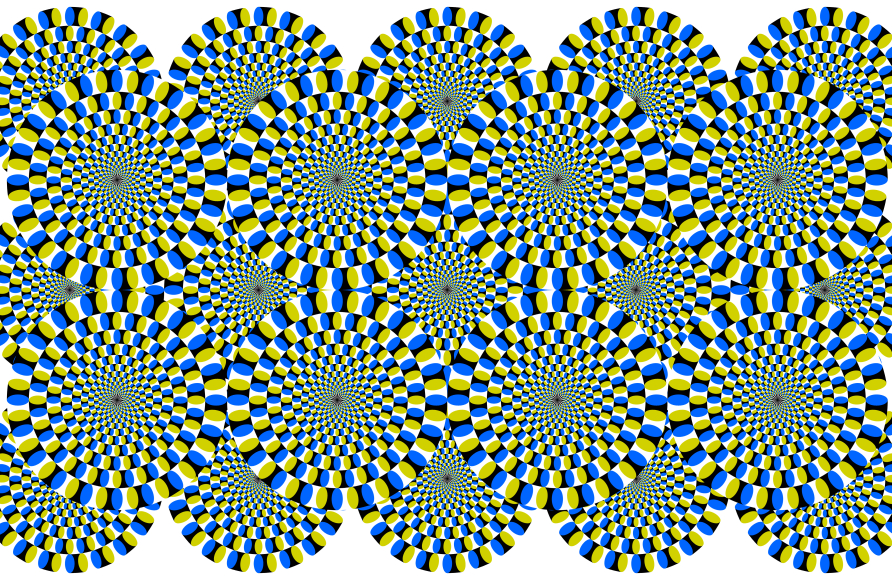
"Rotating snakes 3D #2"
If observers cross-fuse this autostereogram, six disks appear to be in front. Of them, the upper three appear to rotate clockwise while the lower three counterclockwise.
Copyright Akiyoshi.Kitaoka 2006 (September 4)
"Three-dimensionally rotating corrugated mesh"
This is an autostereogram. For uncross-fusers, the upper image appears to rotate clockwise along a vertical axis if it is observed from above while the lower image counterclockwise. For cross-fusers, the upper image appears to rotate counterclockwise along a vertical axis if it is observed from above while the lower image clockwise.
Copyright Akiyoshi Kitaoka 2006 (August 23, revised September 4)
Handout (MS-Word doc file, 15MB)
"3D rotation of 3D-waving pattern"
This is an autostereogram, in which the image appears to wave in depth and rotate along a vertical axis.
Copyright Akiyoshi Kitaoka 2006 (August 22)
Question: Can illusory motion alone give the illusory motion in depth?
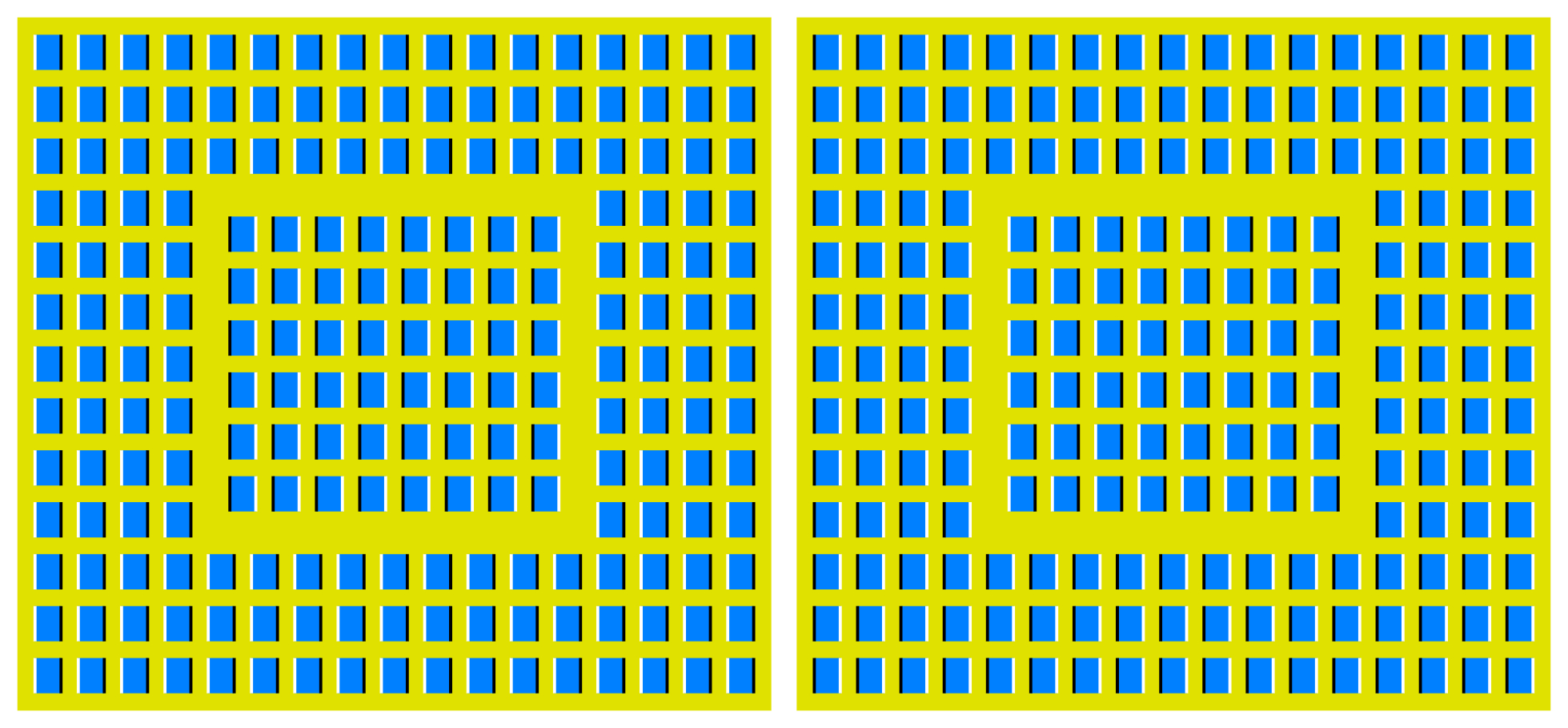
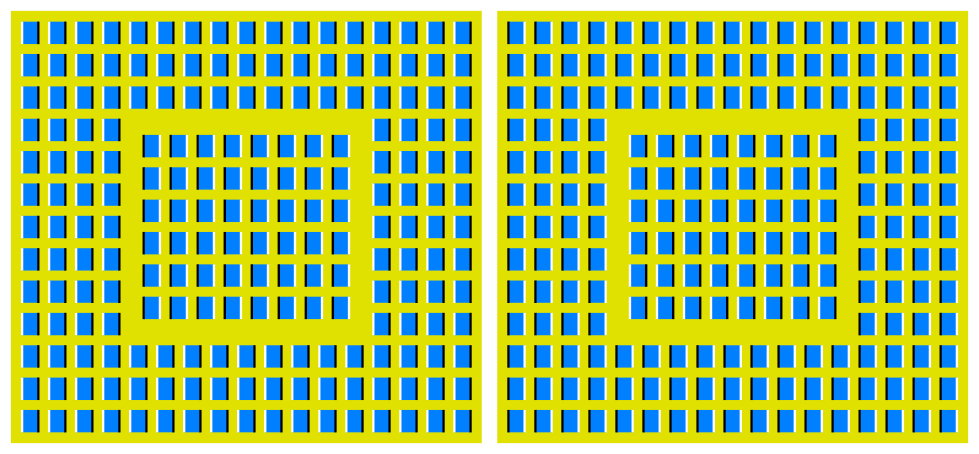
"Sliding tiles 3D"
Motion
illusion: The inset of the left image appears to slide rightward while that of the
right image leftward.
Binocular stereopsis: When fusing the two images, cross-fusers see the inset in front of the
surround, though there is no disparity between blue rectangles. The reversal
is observed for uncross-fussers.1)
Copyright Akiyoshi Kitaoka 2006 (August 22)
1)Gregory R L, Heard P F, 1983 gVisual dissociations of movement, position, and stereo depthh Quarterly Journal of Experimental Psychology 35A 217-237
Answer: Illusory motion alone cannot give the illusory motion in depth! (If any, it's very weak)
"Illusion buildings"
Motion
illusion: In the left building, the
upper half appears to move leftward while the lower half rightward. The reversal
appears in the right building.
Position illusion: The blue windows are aligned vertically, but in the left building the
ones in the upper half appear to be slightly shifted rightward as compared with
those in the lower half. The reversal appears in the right
building.1)
Binocular stereopsis: When
fusing the two buildings, cross-fusers see the lower half appears to be in front
of the upper half. The reversal is observed for
uncross-fusers.1)
Copyright Akiyoshi Kitaoka 2006 (August 9)
1)Gregory R L, Heard P F, 1983 gVisual dissociations of movement, position, and stereo depthh Quarterly Journal of Experimental Psychology 35A 217-237
My opinion: Nevertheless, I claim there may be some relationship between anomalous motion illusion and stereopsis
Topic 1: What is anomalous motion illusion?
In this talk, anomalous motion illusion refers to illusory motion in a stationary image.
Example
Ouchi illusion (Ouchi, 1977; Spillmann et al., 1986)
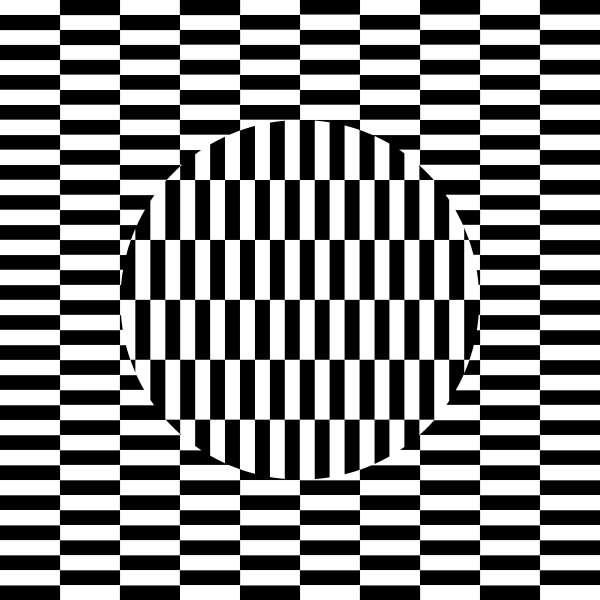
The inset appears to move.
Ouchi, H. (1977) Japanese optical and geometrical art. Mineola, NY: Dover.
Spillmann, L., Heitger, F. and Schuller, S. (1986) Apparent displacement
and phase unlocking in checkerboard patterns. Paper presented at the 9th
European Conference on Visual Perception, Bad Nauheim
My classification of anomalous motion illusions
Topic 2: Optimized Fraser-Wilcox illusion
Fraser-Wilcox illusion (Fraser and Wilcox, 1979)
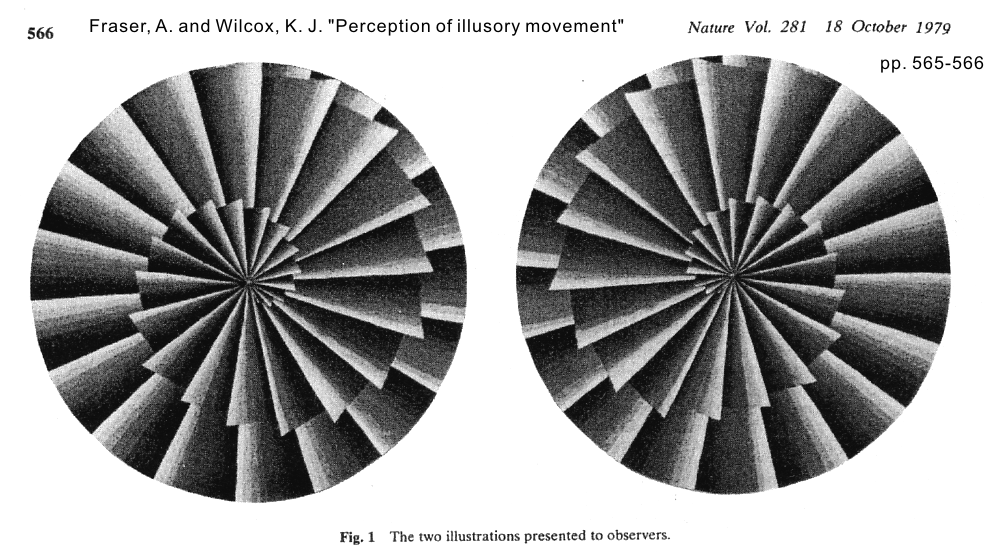
Fraser, A. and Wilcox, K. J. (1979) Perception of illusory movement. Nature, 281, 565-566.
Optimization of the Fraser-Wilcox illusion (Kitaoka and Ashida, 2003)

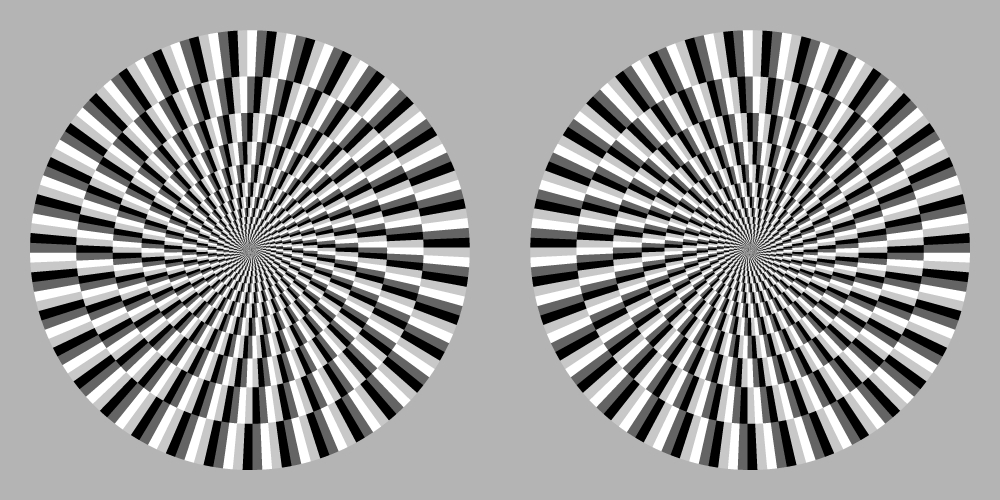
Kitaoka, A. and Ashida, H. (2003) Phenomenal characteristics of the peripheral drift illusion. VISION (Journal of the Vision Society of Japan), 15, 261-262
Classification of the optimized Fraser-Wilcox illusion
(September 2006 version)
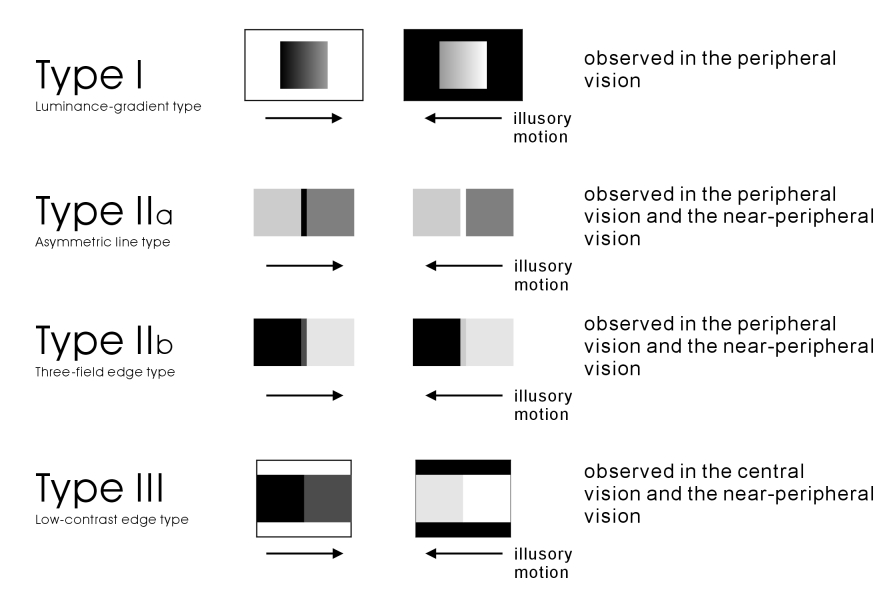
Optimized Fraser-Wilcox illusion Type I Example
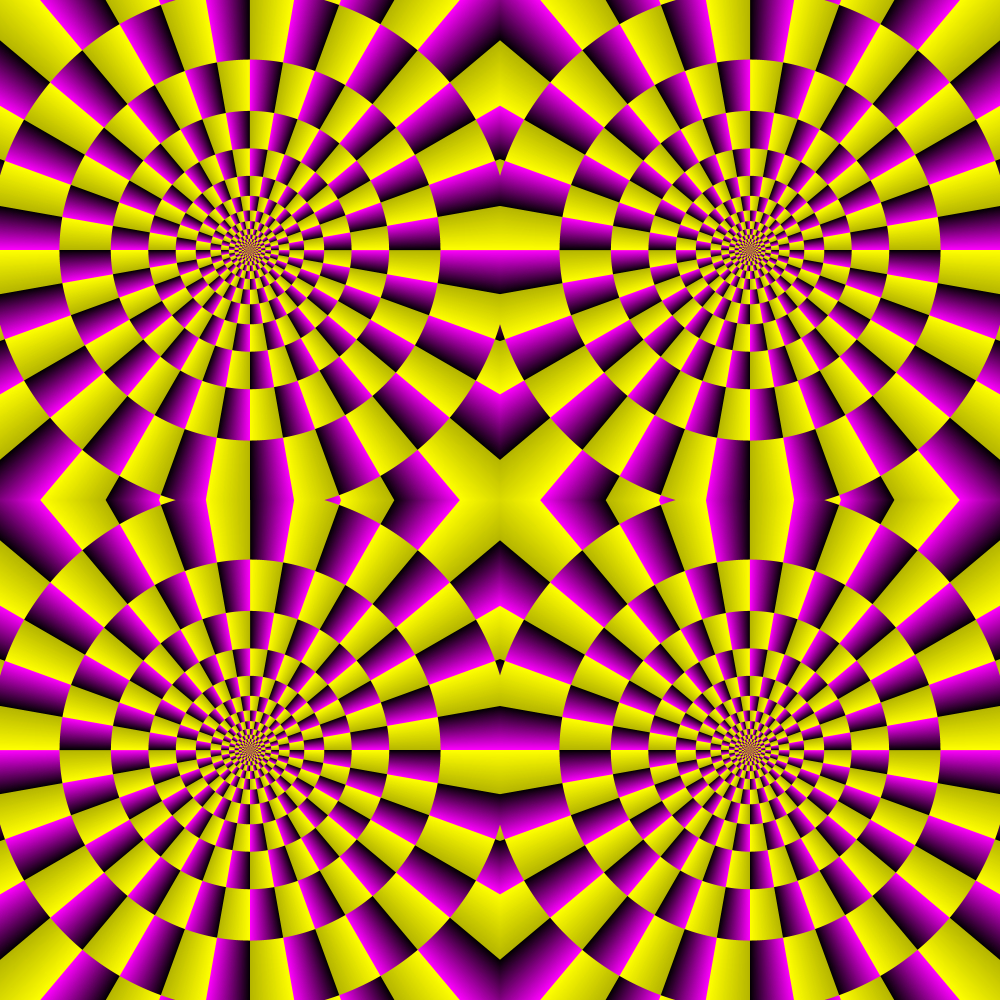
"The time tunnel show"
Rings appear to rotate.
Copyright Akiyoshi.Kitaoka 2006 (February24)
Optimized Fraser-Wilcox illusion Type IIa Example
"Brownian
motion"
(a remake)
Particles appear to move.
Copyright Akiyoshi Kitaoka 2006 (September 6)
Optimized Fraser-Wilcox illusion Type IIb Example
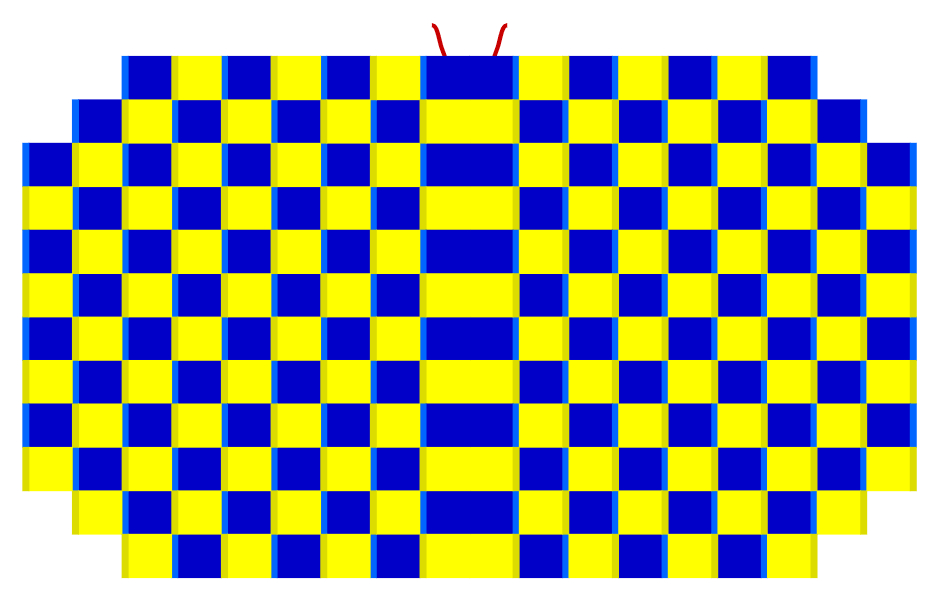
"Hatching out"
Wings appear to expand. In addition, the illusory motion in the opposite direction can be observed when observers keep blinking.
Copyright Akiyoshi.Kitaoka 2006 (May 14)
Optimized Fraser-Wilcox illusion Type III Example
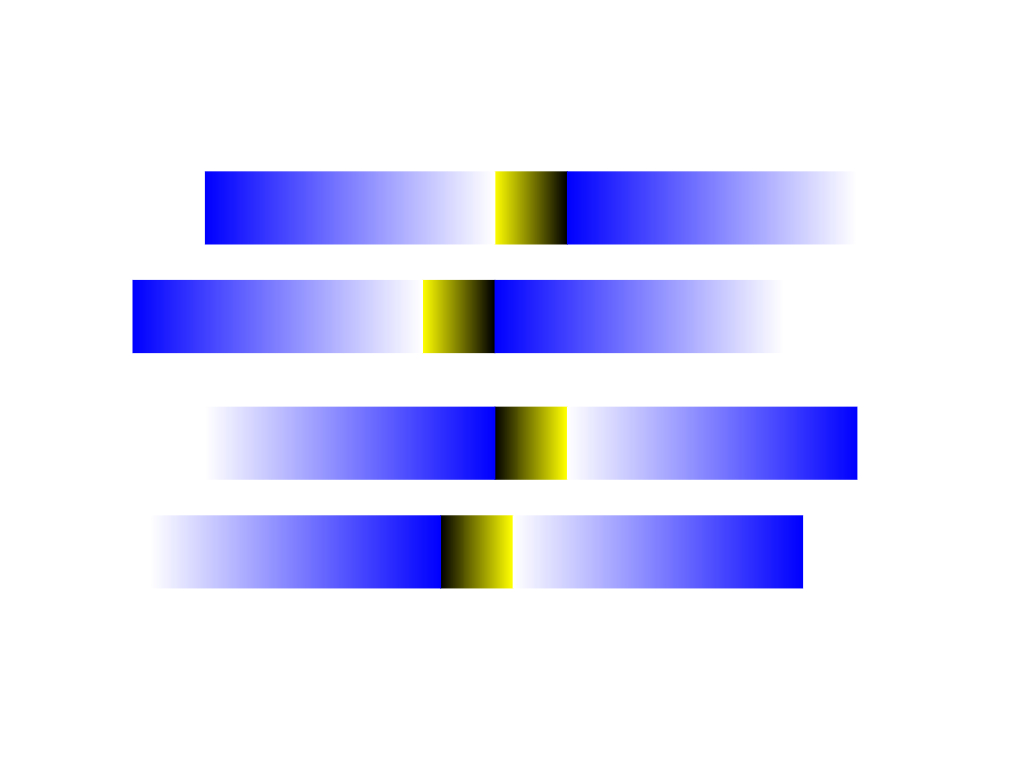
"Urban railways"
The upper two rows appear to move rightward while the lower two ones appear to move leftward.
Copyright Akiyoshi Kitaoka 2005 (September 16)
In this talk, Type IIa and Type IIb are focused on.
"Blue octopus Tako-no-hacchan"
Each disk appears to expand.
Copyright Akiyoshi Kitaoka 2006 (May 2)

Topic 3: Reversed phi movement
Reversed phi movement (Anstis, 1970)

Anstis S M, 1970 "Phi movement as a subtraction process" Vision Research 10 1411-1430
Standard (stroboscopic) reversed phi
Phenomenal phenomena (Gregory and Heard, 1983)

Gregory R L, Heard P F, 1983 "Visual dissociations of movement, position, and stereo depth" Quarterly Journal of Experimental Psychology 35A 217-237
"Phi movement" (Anstis and Rogers, 1975)

Anstis S M, Rogers B J, 1975 "Illusory reversal of visual depth and movement during changes of contrast" Vision Research 15 957-961
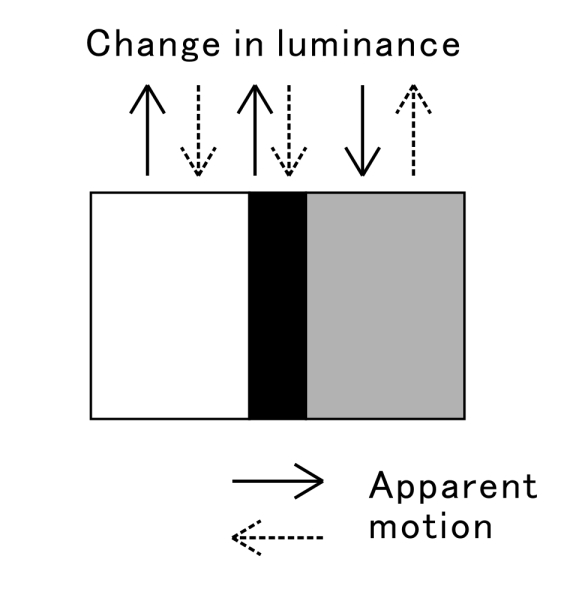
For demonstration, see Animation 8 of this animation page attached to the paper below.
------------------------
Kitaoka, A. (2006) Configurational coincidence among six phenomena: A comment on van Lier and Csathó (2006). Perception, 35, 799-806.
Shapiro, A. G., Charles, J. P., & Shear-Heyman, M. (2005). Visual illusions based on single-field contrast asynchronies. Journal of Vision, 5(10), 764-782
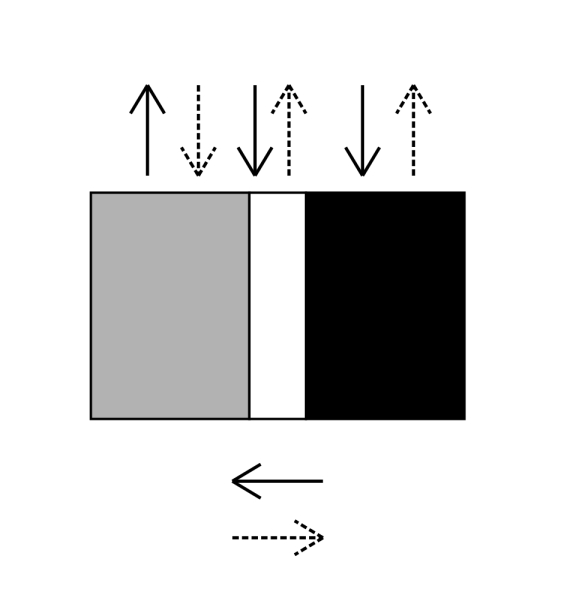
For demonstration, see Animation 8 of this page.
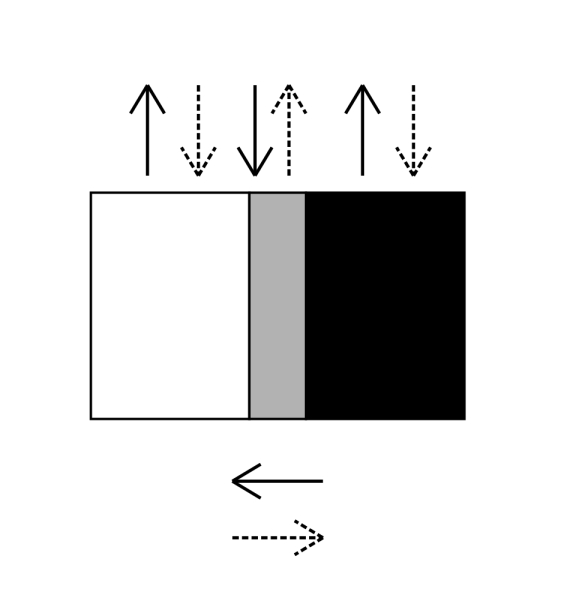
For demonstration, see Animation 8 of this page.
My explanation of the reversed phi movement
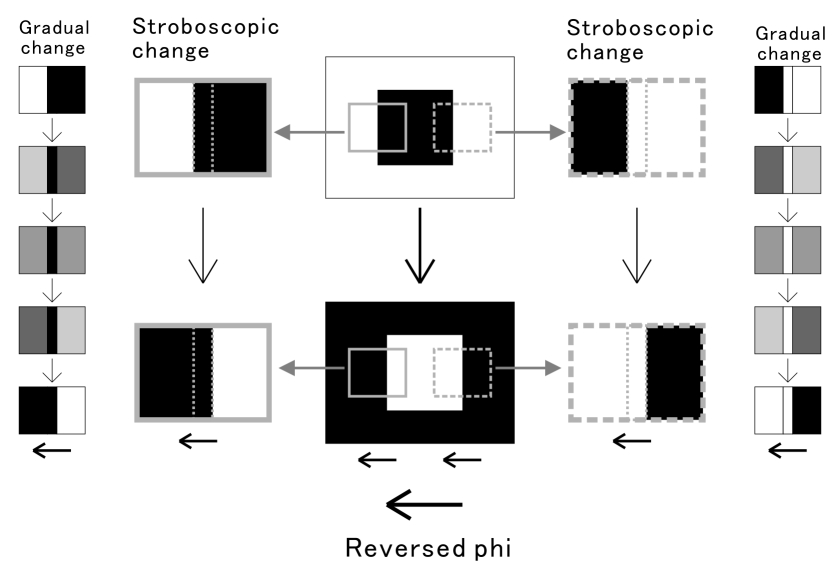
Standard (stroboscopic) reversed phi
Stereopsis in this situation
(a) The Gregory-Heard stereopsis agree with the positional illusion, but
disagree with phenomenal phenomena.
(b) The Anstis-Rogers stereopsis disagree with the positional illusion,
but agrees with reversed phi.
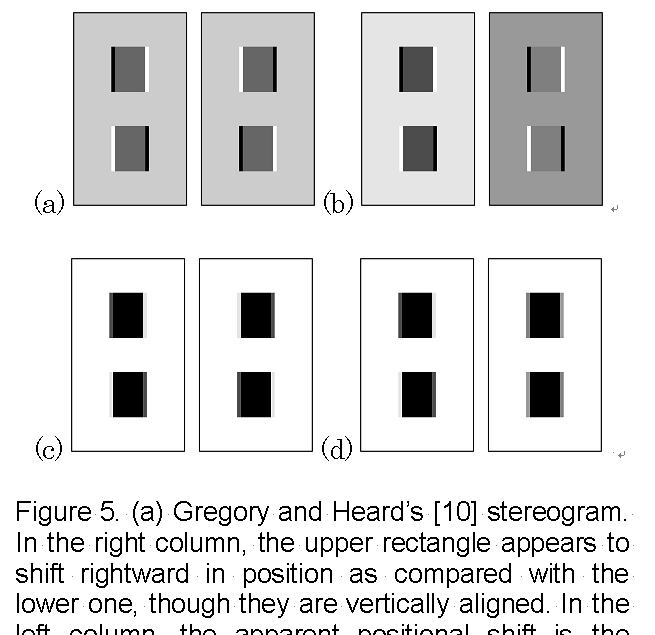
For the full legend, see Figure 5 in kitaoka3D2006.doc.
(Luminance-change-dependent motion illusion Type A = Reversed phi and phenomenal phenomena)
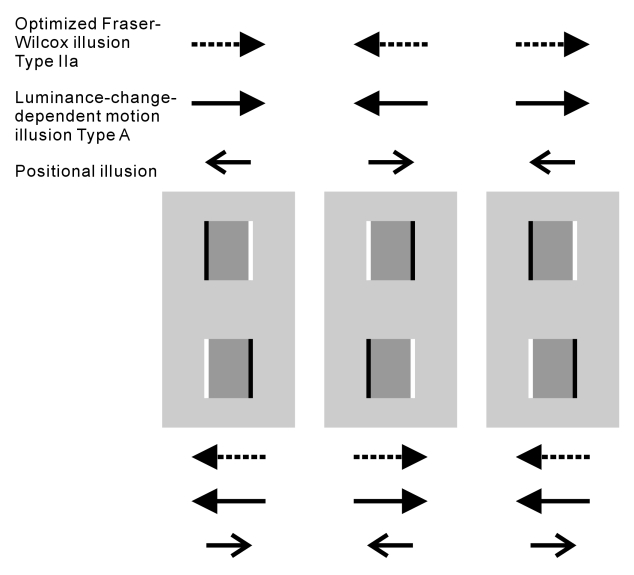
(Luminance-change-dependent motion illusion Type A = Reversed phi and phenomenal phenomena)
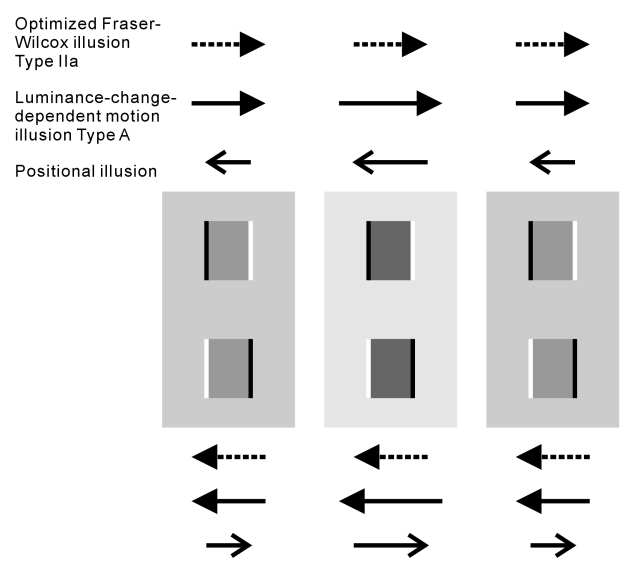
(Luminance-change-dependent motion illusion Type B = "phi movement"
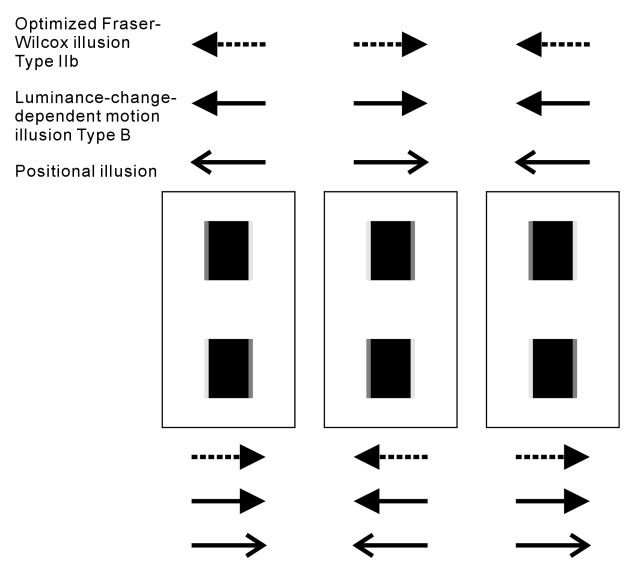
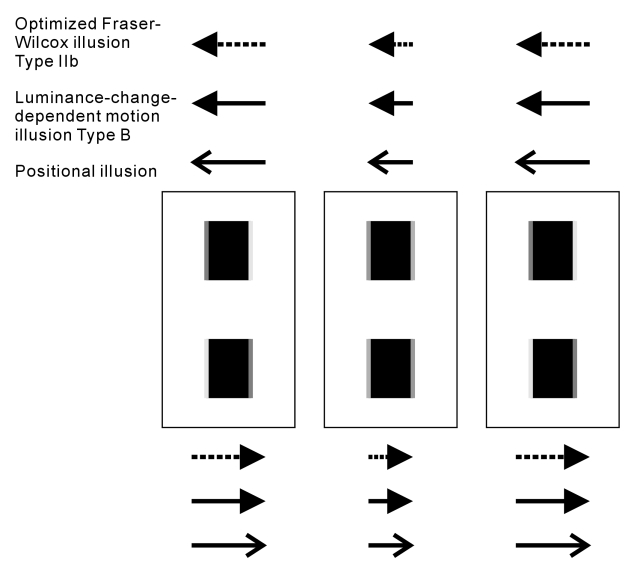
Summary: (1) The optimized Fraser-Wilcox illusion Type IIa agrees with reversed
phi and phenomenal phenomena, and agree with the Anstis-Rogers stereopsis,
but disagree with the positional illusion or the Gregory-Heard stereopsis.
(2) The optimized Fraser-Wilcox illusion Type IIb agrees with "phi movement",
the positional illusion and the stereopsis.
But,
My view: I have failed to propose critical evidence for the relationship between anomalous motion illusion and stereopsis.
But,
My speculation: There are neurons that have a receptive field of three subfields, being a thin field flanked by thick fieds of different luminance profiles. Moreover, activity of such neurons underly a variety of visual effects or illusions ranging the perception of motion, position, or stereopsis.
Thank you.

"Lake Ritsumeikan"
It appears as if there were a lake in the campus of the Ritsumeikan University.
Copyright A.Kitaoka 2006 (August 14)
Appendix
Synthesis of reversed phi movement and phi movement (1)
Illusion magnitude appears to be greater than each effect.
Synthesis of reversed phi movement and phi movement (2)
Illusion magnitude appears to be greater than each effect.
Four-frame reversed phi movement
Two-frame reversed phi movement (standard reversed phi)
I think that the apparent rotation of "Rotating snakes" depends on Type IIa.
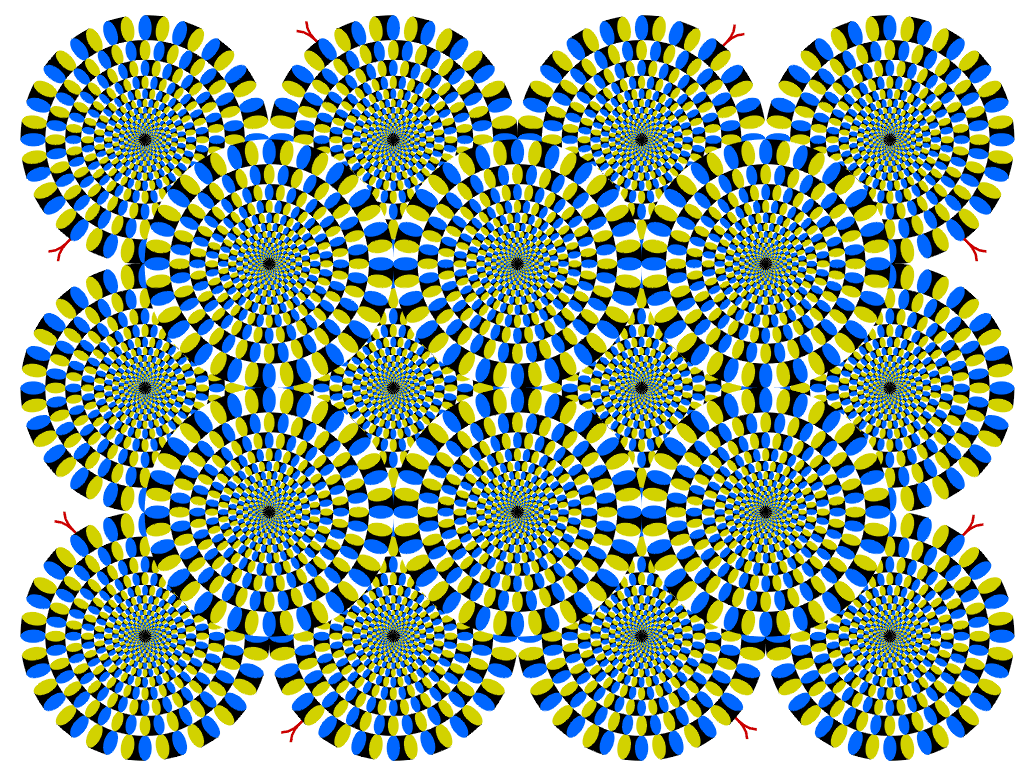
"Rotating snakes"
Circular snakes appear to rotate 'spontaneously'.
Copyright A.Kitaoka 2003 (September 2, 2003)
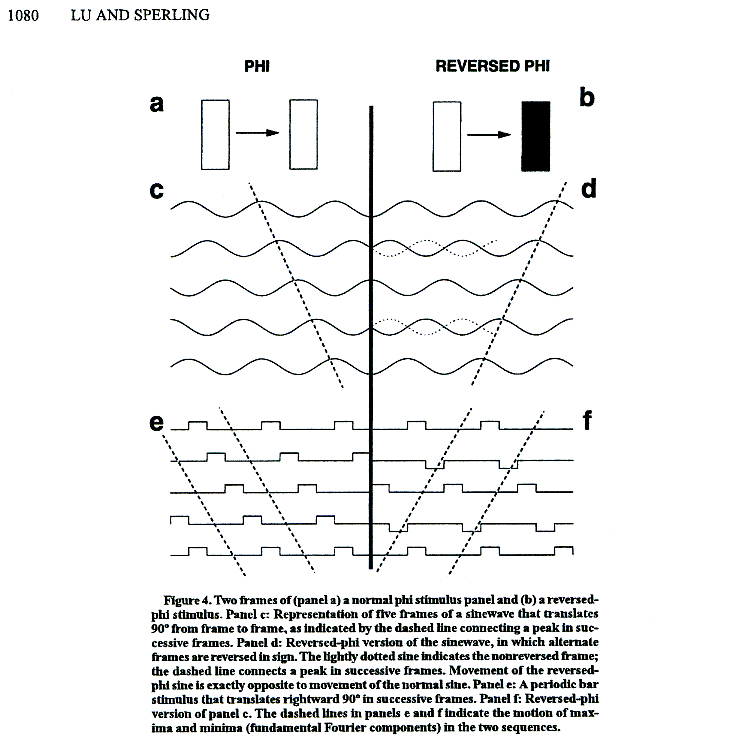
Lu, Z-L. and Sperling, G. (1999) Second-order reversed phi. Perception & Psychophysics, 61, 1075-1088.